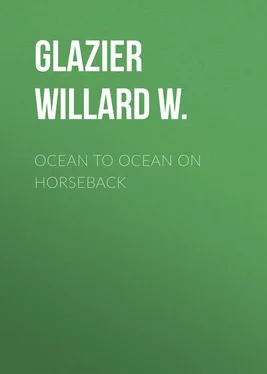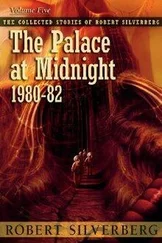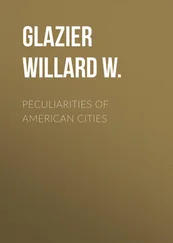Willard Glazier - Ocean to Ocean on Horseback
Здесь есть возможность читать онлайн «Willard Glazier - Ocean to Ocean on Horseback» — ознакомительный отрывок электронной книги совершенно бесплатно, а после прочтения отрывка купить полную версию. В некоторых случаях можно слушать аудио, скачать через торрент в формате fb2 и присутствует краткое содержание. Жанр: foreign_antique, foreign_prose, Путешествия и география, на английском языке. Описание произведения, (предисловие) а так же отзывы посетителей доступны на портале библиотеки ЛибКат.
- Название:Ocean to Ocean on Horseback
- Автор:
- Жанр:
- Год:неизвестен
- ISBN:нет данных
- Рейтинг книги:4 / 5. Голосов: 1
-
Избранное:Добавить в избранное
- Отзывы:
-
Ваша оценка:
- 80
- 1
- 2
- 3
- 4
- 5
Ocean to Ocean on Horseback: краткое содержание, описание и аннотация
Предлагаем к чтению аннотацию, описание, краткое содержание или предисловие (зависит от того, что написал сам автор книги «Ocean to Ocean on Horseback»). Если вы не нашли необходимую информацию о книге — напишите в комментариях, мы постараемся отыскать её.
Ocean to Ocean on Horseback — читать онлайн ознакомительный отрывок
Ниже представлен текст книги, разбитый по страницам. Система сохранения места последней прочитанной страницы, позволяет с удобством читать онлайн бесплатно книгу «Ocean to Ocean on Horseback», без необходимости каждый раз заново искать на чём Вы остановились. Поставьте закладку, и сможете в любой момент перейти на страницу, на которой закончили чтение.
Интервал:
Закладка:
All good Bostonians, like the rest of their countrymen, may wish to go to Paris when they die – that point cannot be settled; but it is certain that they all wish to go to the Back-Bay while they live. And who can wonder? To drive at night down Commonwealth avenue, the most aristocratic street in this aristocratic quarter, is to view a scene from fairyland. "The Avenue" itself is 250 feet wide from house to house and 175 feet wide from curb to curb, and in the centre a picturesque strip of parkland, adorned with statues and bordered with ornamental trees and shrubs, follows its entire length. On either side of the street stand palatial hotels and magnificent private residences, from whose innumerable windows twinkle innumerable lights, which, mingling with the quadruple row of gas-lamps which look like a winding ribbon of light, make the vista perfectly dazzling in its beauty. By day, when the Back Bay Park, the Public Garden, the fine bridge over the park water-way extension and the handsome surrounding and intersecting streets can be seen, the view is even more attractive.
In the newer parts of Boston the reproach of crooked streets, which has given her sister cities opportunity for so much good-natured "chaff," is removed, and the thoroughfares are laid out with such precision that "the wayfaring man, though a fool," can hardly "err therein." In the business district much money has been spent on the straightening process, a fact whose knowledge prompts the bewildered stranger to exclaim, "Were they ever worse than this?" Stories aimed at this little peculiarity of the "Hub" are innumerable, the visitor being told with perfect gravity that if he follows a street in a straight line he will find himself at his original starting-point – a statement the writer's experience can pretty nearly verify. The best, if not the most credible, of these tales relates how a puzzled pedestrian, becoming "mixed up in his tracks," endeavored to overtake a man who was walking ahead of him, and inquire his way. The faster he walked, however, the faster the other man walked, until it became a regular chase, and the now thoroughly confused stranger had but one idea – to catch his fellow-pedestrian by the coat-tails, if need be, and demand to be set on his homeward way. Finally, by making a frantic forward lurch, he succeeded – and discovered that the coat-tails he was grasping were his own!
The true Bostonian is secretly rather proud, however, of this distinguished trait of his beloved city, and is willing to go "all around Robin Hood's barn" to get to his destination.
But the thing of which the Bostonian is proudest of all is his famous Common, whose green turf and noble shade-trees have formed a stage and background for so many of the most exciting scenes of Colonial and Revolutionary history. Among the troops which have been mustered and drilled upon it were a portion of the forces which captured Quebec and Louisburg; and the rehearsals for the grim drama of war, which later was partly performed on the same ground by red-coat and continental, took place here. It was at the Common's foot that the hated "lobster-backs" assembled before embarking for Lexington; on the Common that they marshalled their forces for the conflict at Bunker Hill. It has been covered with white tents during the British occupation of Boston; dotted with earthworks behind which the enemy crouched, expecting an attack by Washington upon their stronghold. It was on Boston Common that the school-boys constructed their snowmen, whose destruction by the insolent red-coats sent an indignant deputation of young Bostonians to complain to General Gage, who, stunned by what the young Bostonian of to-day would designate as "the cheek of the thing," promised them redress, and exclaimed, "These boys seem to take in the love of liberty with the very air they breathe."
There are other interesting historical incidents, recorded in connection with the Common, but space forbids their narration. I would rather describe it as it first appeared to me, a beautiful surprise, a gracious spot of greenness and of silvery waters and splendid shade-trees, in the heart of the busy brick-bound city. Here the children play and coast, as they did in the days of General Gage; here the lovers walk, on the five beautiful broad pathways, the Tremont street, Park street, Beacon street, Charles street and Boylston street malls. Here the invalids and old folks rest on the numerous benches; here the people congregate on summer evenings to enjoy the free open-air concerts, which are given from the band-stand. "Frog Pond," a pretty lakelet, near Flagstaff Hill, and a fine deer-park in the vicinity of the Boylston street mall, are great attractions. The Common covers forty-eight acres, with 1000 stately old shade-trees, and the iron fence by which it is inclosed measures 5932 feet.
In addition to its natural beauties, the Common has two fine pieces of statuary, the Soldiers' and Sailors' Monument on Flagstaff Hill, and the Brener Fountain. The former was erected in 1871 at a cost of $75,000. It is a majestic granite shaft in the Roman-Doric style, seventy feet high, surmounted by a bronze figure of the Genius of America, eleven feet in height. At the base of the shaft are grouped alto-relievo figures representing the North, the South, the East, and the West. Four other bronze figures, representing Peace, History, the Army and the Navy, stand on projecting pedestals around the foundation. The monument, which was executed by Martin Milmore, was Boston's tribute to her fallen heroes of the Civil War. The Brener Fountain is a beautiful bronze casting designed by Lienard, of Paris, with bronze figures representing Neptune, Amphitrite, Acis, and Galatea grouped round the base. The late Gardner Brener presented it to the city in 1868.
To forget the Old Elm in describing the Common, would be rank disrespect to that hoary "oldest inhabitant," albeit nothing remains of it now but its memory. An iron fence surrounds the spot where once it stood, and a vigorous young sapling has providentially sprung up in its place, as a successor. The Old Elm was ancient in 1630, when the town was settled, and was one of its most interesting landmarks up to 1876, when it was blown down.
The Public Garden, from which the beautiful Commonwealth avenue begins, the Back-Bay Park, which cost a million of dollars, and the Arnold Arboretum, where Harvard University has planted and maintained a fine horticultural collection for the pleasure of the public, are lovely spots on whose beauty the mind would fain linger, but whose descriptions must be omitted, for all Boston's splendid public buildings wait in stately array their share of attention. Nowhere has the skilled artist-architect been so freely permitted to carry out his designs unhampered by stupidity and stinginess as in Boston, and the result has been a collection of public buildings unsurpassed by those of any modern city. The Boston State House comes first, of course – did not the "Autocrat of the Breakfast Table" term it, with loving exaggeration, the "Hub of the Solar System?" From Beacon Hill, the most prominent coign of vantage which could be selected for it, its gilded dome rises majestically against the blue sky and imperiously beckons the visitor to come and pay his respects to this most venerated of Boston institutions. The State House stands, at a height of 110 feet, at the junction of Beacon and Mt. Vernon streets and Hancock avenue, on a lot which Governor Hancock once used for pasturing his cows, and was erected in 1795, beginning its existence in a blaze of glory, with the corner-stone laid by Paul Revere, then Grand Master of the Masons, and an oration by Samuel Adams. The building contains Doric Hall, which is approached by a fine series of stone terraces from Beacon street; Hall of Representatives, the Senate Chamber, the Government Room, and the State Library.
Читать дальшеИнтервал:
Закладка:
Похожие книги на «Ocean to Ocean on Horseback»
Представляем Вашему вниманию похожие книги на «Ocean to Ocean on Horseback» списком для выбора. Мы отобрали схожую по названию и смыслу литературу в надежде предоставить читателям больше вариантов отыскать новые, интересные, ещё непрочитанные произведения.
Обсуждение, отзывы о книге «Ocean to Ocean on Horseback» и просто собственные мнения читателей. Оставьте ваши комментарии, напишите, что Вы думаете о произведении, его смысле или главных героях. Укажите что конкретно понравилось, а что нет, и почему Вы так считаете.





![Джон Сэндфорд - Ocean Prey [calibre]](/books/384313/dzhon-sendford-ocean-prey-calibre-thumb.webp)






